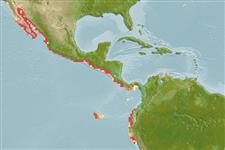Classification / Names
Common names from other countries
Main reference
Size / Weight / Age
Max length : 150 cm TL male/unsexed; (Ref. 5222); max. published weight: 91.0 kg (Ref. 2850)
Environment
Marine; brackish; demersal; depth range 0 - 60 m (Ref. 9342)
Climate / Range
Subtropical, preferred 28°C (Ref. 107945); 34°N - 9°S, 118°W - 79°W (Ref. 5222)
Distribution
Short description
Dorsal
spines
(total): 11;
Dorsal
soft rays
(total): 15-16;
Anal
spines: 3;
Anal
soft rays: 10 - 11. Distinguished by the following characteristics: two color patterns, first is brown blotched pattern, grey or greyish green with oblong dark blotches dorsally, forming an irregular maze-like, pale reticulum, second is plain colored pattern is uniform greyish brown, darker fins and edged with white; depth of body contained 2.9-3.1 times in SL; head length 2.6-2.8 times in SL; angular preopercle, with distinct serrate lobe at angle; posterior nostrils notably larger than anterior nostrils (Ref. 89707).
IUCN Red List Status (Ref. 115185)
Threat to humans
Harmless
Human uses
Fisheries: minor commercial; gamefish: yes
More information
ReferencesAquacultureAquaculture profileStrainsGeneticsAllele frequenciesHeritabilityDiseasesProcessingMass conversion
Tools
Special reports
Download XML
Internet sources
Estimates of some properties based on models
Phylogenetic diversity index
PD50 = 0.5000 many relatives (e.g. carps) 0.5 - 2.0 few relatives (e.g. lungfishes)
Trophic Level
4.5 ±0.8 se; Based on size and trophs of closest relatives
Resilience
Low, minimum population doubling time 4.5 - 14 years (Musick et al. 2000 (Ref. 36717))
Vulnerability
Very high vulnerability (83 of 100)
Price category
